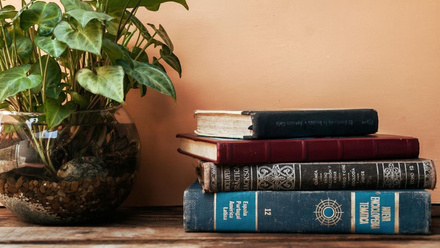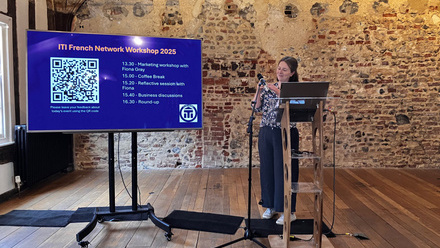Inscribing verse
The words ‘pottery’ and ‘poetry’ are near-anagrams, but that’s not their only similarity. They are both food for the mind and soul: reflective, spiritual, relaxing, creative – and for me, each fulfilling the practical and theoretical sides of my personality.
I started potting while I was working as an academic at the University of Glasgow in 2014. It was a real stress relief going to Glasgow Ceramics Studio after work, and I felt it turned a buzzing mind into a calm one – rather like working on poetry translation, which is also very slowpaced and considered.
World in lockdown: operation pottery studio
Then came the pandemic. Life changed dramatically. I had been earning a good living as a freelance marketing translator, doing some literary translation on the side. Then in March 2020 I received no job requests at all. That’s when ‘operation pottery studio’ began! I started by clearing my garage of tons of boxes and spiders, decorating the brickwork and sealing all the draughty holes. It kept my mind busy in the hours before the daily Covid updates.
Soon afterwards, I ordered my potter’s wheel, kiln, tools and clay, and I started making and practising in the April. Translation work did pick up a little, but essentially I had time that I had never had before to pursue ceramics. I named my studio Iremia Pottery. Iremia means peace and tranquillity in Greek: I felt this reflected my linguistic background, the holidays I’ve had with my Greek family over the years, and the calm and serenity that pottery brings me.
Putting poetry on the pots
Months passed, however, without literary translation, and Covid meant I couldn’t travel to Cameroon in 2020 to pursue a literary translation project with Bristol University and Bakwa Magazine in Yaoundé. So, I started to have literary withdrawal symptoms and began translating poetry more purposefully again. I also looked through my favourite translations of poetry over the past 15 years. I first published a collection in 2007, entitled The Other Half of History. It is a bilingual anthology of Francophone African women’s poetry, including both source texts and my own translations. I have also published works in Modern Poetry in Translation and Paraguay Press’s Active Art, as well as in academic articles and magazines, and I have plenty of unpublished work too. I was interested to see whether particular lines or phrases might work well on my ceramics and inspire individual design concepts.
It could be argued that removing an individual line from a poem and painting it on a pot will inevitably alter the source text author’s so-called ‘intended meaning’, as there is no written context. That’s true: it can and it will. However, I don’t see this as something negative, but rather another form of translation, through editing and intersemiotic translation (translating words to visual design): from paper to pot! And my hope is that people reading a line of a poem that they enjoy may read on and research where that line came from. I sought, then, to find phrases that could stand alone, but had a wider resonance, especially in the present day; in other words, lines that had a broad political, philosophical, social or cultural relevance.
For example, I translated the work of Egyptian-French author Joyce Mansour for The Other Half of History. I felt that there was one line in a poem I’d translated that was particularly powerful in the age of reality TV fame, social media and trolling: ‘Bury your dreams in the bags beneath your eyes, they will be safe from envy.’ I also felt her poetry was particularly visual and it translated well into a pottery design concept. I threw a large plate on the potter’s wheel using an earthenware clay, then fired it to 1,186 degrees Celsius before using underglaze paints to create the basic design including the poetry. I then dipped the bisqueware in a transparent glaze before adding glass beads to create the ‘green with envy’ effect. These melted and fused with the glaze in the kiln, which was fired for a second time to 1,031 degrees.
It takes time to get the right effect
Pottery, equally, requires time and a high level of patience, whether that’s patience on the wheel, throwing time after time to improve your skills, or patience in hand-building or decorating, keeping a slow and steady hand to build or create intricate designs. The greatest demand on your patience, however, is the wait before opening the kiln. Do it too early and the glaze may crackle, but hold your nerve and you can eventually open up to an amazing and satisfying glaze effect.
I created an interesting glaze effect on a vase I threw and decorated with the words of French poet Laura Boullic. Laura is highly philosophical and challenging in terms of interpretation. I’ve translated a number of her songs, some poetry and prose. She writes, ‘I only silence effort, for effort I breathe’. Does this refer to the stresses and strains of modern life, overworking, issues of anxiety and depression, especially resonant over the period of the pandemic? Possibly. I certainly took inspiration from this interpretation in the decoration, painting her words surrounded by the calm of sea blue against the political power of gold.
Find a balance
When it comes to translation strategy, with poetry and poetic prose I always try to find that balance between style and the different layers of potential meaning as well as cultural reverberations. Often, in poetry influenced by orality or written to be performed, strict linguistic word-for-word meaning is less important than rhythms, rhyme, alliteration and so on. However, I rarely stray from the overarching sense of a poem, and each of the translated lines I have used on pots has actually been translated in the context of the full source text. Then removing each line or two lines from a poem broadens its possible interpretations.
I feel the design and that sense of detachment from others also worked well for the line from a poem by Agnès Olive of Réunion: ‘The angels who populate this earth are hurting each other’. The year and a half over which we’ve endured the pandemic has also been a period where issues of racism, violence against women, and bullying have come to the fore, and the solitary figure on this piece I do hope conveys some of this meaning to those who see it.
Giving the poem a different and new life
I find both poetry translation and pottery are highly thought-provoking in this way, and as solitary activities, they appeal to my more introverted side. At the same time, passing on pottery through teaching or performing my poetry appeals to the extrovert in me! The words and the wheel give me that balance. Both activities are also intellectually stimulating. For example, poetry challenges through linguistics, research, problem-solving and so on. One of the most complex sides to pottery is the chemistry as I develop glazes and need to use the kiln to best effect. This depends on numerous variables, from ambient temperature to water content and physical position during firing. Both pottery and poetry lead to something tangible at the end, which is highly satisfying.
One of my most satisfying poetic pots has to be my first ever coil pot, decorated with the words of Senegalese poet Mame Seck Mbacké. Her modernist style is challenging to translate, but I love the fact that her poems engage with local histories and cultures. I chose the line: ‘I want to walk with you on the ochre land of the Ferlo and breathe the sweet silence of Djollof nights’ for it takes us back to the largely precolonial era in West Africa, conjuring up images of the Ferlo desert and the Djollof kingdom that existed between 1549 and 1890. My design also includes traditional Adinkra symbols that were often used historically on pottery, including one meaning unity in diversity (see picture), which I believe has cultural resonance on the continent today. Alternatively, someone may read that line of poetry, and simply imagine a beautiful and romantic African landscape.
However we interpret all these poetic lines, of course, is up to the individual. But I’d like to think that my pottery allows poetry to live a new life through the medium of visual art, and offers a very different platform to highlight the work of these poets as well as underlining the practice of literary translation to those interested in ceramics. The authors’ names are written on the undersides of the pots (alongside my own mark), which are all turned (trimmed and refined) on the wheel, so it would be nice to think that people go on to seek out the work of these writers and reimagine these lines in their original context.
Practical and theoretical union
In terms of my own pottery and poetry, I recently took a stall at my first craft fair and managed to sell two-thirds of my pots to new owners! I’ve also had my first commissions, including vases, bowls, mugs and cake stands, and started teaching pottery taster sessions on the wheel in September, hopefully passing on the bug but also the stress-busting experience of ceramics. I will continue to produce poetic pots as one of my ranges of keepsake ceramics, and keep translating French and Francophone poetry, always seeking out beautiful words that make us reflect on the world but also inspire my own design concepts. For me, it’s the perfect marriage between the practical and the theoretical, but also the ideal combination of my two favourite passions.
Never miss another Bulletin article

If you would like to read more features and articles on a wide variety of subjects relating to all aspects of the translation and interpreting industry, subscribe to ITI Bulletin. Alternatively, join ITI and get a free subscription included in your membership.






